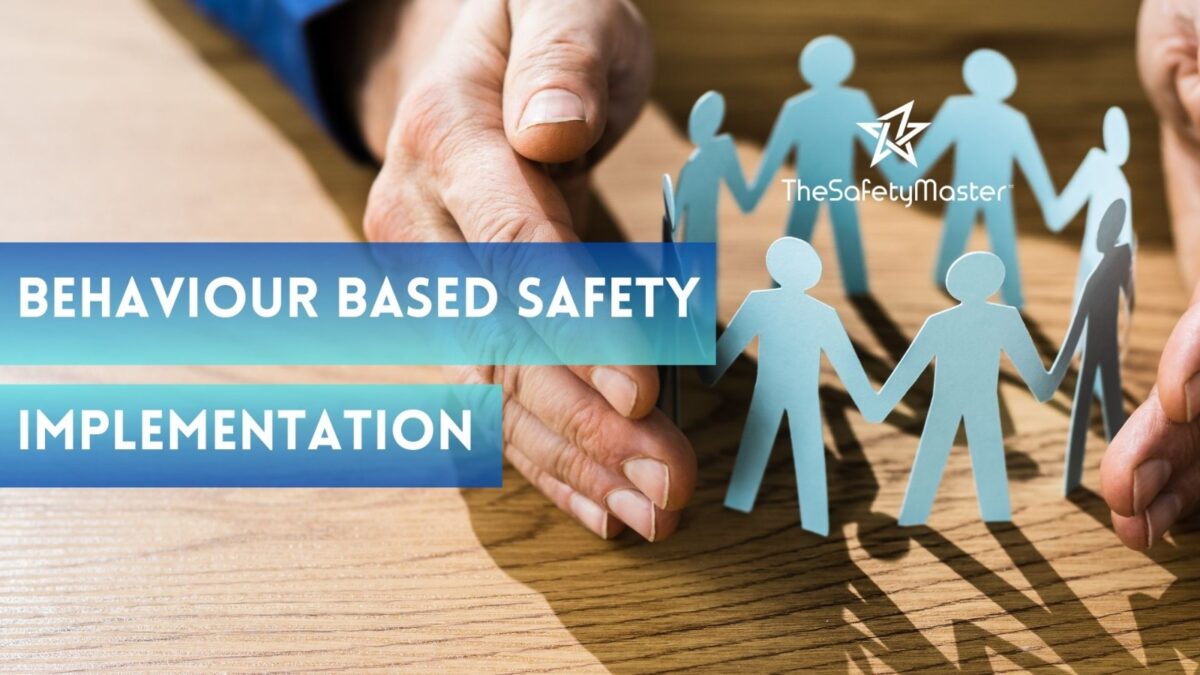BBS Implementation for Safety Culture Transformation for Zero Incident

BBS Training for all employees of a company – The Safety Master
January 24, 2024
BIS 14489 Safety Audit: Mitigating Potential Risks and Strengthening Safety Measures in Your Organization
January 27, 2024In the fast-paced world of industry and business, safety culture stands as a cornerstone for sustainable success. Companies are increasingly turning to innovative approaches like Behavior-Based Safety (BBS) to not only ensure the well-being of their workforce but also to foster a zero-incident environment. In this article, we’ll explore the intricacies of implementing BBS for a transformative safety culture.
Introduction
Ensuring a safe workplace is more than a legal requirement—it’s a moral obligation. BBS emerges as a beacon in this pursuit, offering a proactive strategy that focuses on observable behaviors to prevent accidents. As we delve into this transformative approach, it’s crucial to understand the key components of BBS and its profound impact on safety culture.
Understanding BBS Implementation
Definition of BBS
Behavior-Based Safety is an approach that identifies and encourages safe behaviors within an organization to reduce accidents and injuries. Unlike traditional safety programs, BBS emphasizes real-time observation and feedback, creating a dynamic and responsive safety culture.
Key Principles of BBS
BBS is built on principles such as positive reinforcement, continuous improvement, and employee involvement. It shifts the focus from punitive measures to understanding and influencing the behaviors that contribute to safety.
Linking BBS to Safety Culture Transformation
BBS doesn’t operate in isolation; it intertwines with safety culture. By emphasizing behavioral changes, BBS becomes a catalyst for transforming the entire safety mindset within an organization.
The Role of Leadership in BBS
Leadership commitment is paramount in BBS implementation. When leaders actively champion safety initiatives, employees are more likely to embrace the necessary changes. This section explores how leadership can steer the BBS ship toward success.
Importance of Leadership Commitment
Leaders set the tone for the entire organization. Demonstrating a genuine commitment to safety encourages a similar commitment throughout all levels of the workforce.
How Leaders Can Drive BBS Implementation
Leadership involvement goes beyond rhetoric. It involves actively participating in safety initiatives, fostering open communication, and leading by example. When leaders prioritize safety, it becomes ingrained in the organizational culture.
Examples of Successful Leadership in BBS
Companies like XYZ Corp. have witnessed remarkable success by having their top executives actively engage in BBS initiatives. This involvement has created a domino effect, permeating a strong safety culture throughout the company.
Employee Involvement in BBS
Empowering employees is a cornerstone of BBS. This section explores how organizations can engage their workforce in the pursuit of safety excellence.
Empowering Employees for Safety
When employees feel they have a voice in safety matters, they become active participants in creating a safer work environment. BBS encourages open communication channels and empowers employees to identify and address safety concerns.
Creating a Culture of Reporting and Feedback
BBS thrives on real-time feedback. Encouraging employees to report unsafe behaviors without fear of reprisal fosters a culture of continuous improvement. This collaborative approach ensures that everyone plays a role in maintaining a safe workplace.
Benefits of Involving Employees in BBS
Beyond safety improvements, involving employees in BBS instills a sense of ownership and pride. Employees become safety advocates, contributing not only to their well-being but also to the overall success of the organization.
Training Programs for BBS
Effective training programs are pivotal in embedding BBS principles into the organizational DNA. This section explores the key elements of successful BBS training.
Developing Effective BBS Training
BBS training should be dynamic, engaging, and tailored to the specific needs of the organization. Interactive workshops, real-life scenarios, and practical exercises help employees understand and internalize BBS concepts.
Continuous Learning and Improvement
BBS is not a one-time initiative. Continuous learning ensures that employees stay vigilant and proactive in identifying and addressing safety issues. Regular training sessions and updates keep BBS at the forefront of the organizational agenda.
Real-World Examples of Successful Training Programs
Companies like ABC Industries have implemented innovative BBS training programs, incorporating virtual reality simulations and interactive modules. These initiatives have proven to be not only effective but also memorable for employees.
Measuring BBS Effectiveness
The success of BBS is measurable through various key performance indicators (KPIs). This section explores the metrics that organizations can use to gauge the effectiveness of their BBS initiatives.
Key Performance Indicators (KPIs) for BBS
From incident rates and near-miss reports to employee participation in safety activities, KPIs provide valuable insights into the impact of BBS. Establishing clear metrics helps organizations track progress and identify areas for improvement.
Implementing Feedback Loops
Feedback loops are integral to the continuous improvement philosophy of BBS. Regular assessments, employee surveys, and feedback sessions create a loop that allows organizations to adapt and refine their BBS strategies.
Case Studies Showcasing Successful Measurement Strategies
Companies like DEF Manufacturing have implemented robust measurement strategies, linking BBS effectiveness to a reduction in accidents and injuries. These case studies serve as inspiration for other organizations seeking to quantify the impact of BBS.
Overcoming Challenges in BBS Implementation
While BBS offers tremendous benefits, its implementation is not without challenges. This section explores common hurdles and strategies for overcoming resistance.
Common Hurdles in Adopting BBS
Resistance to change, lack of awareness, and skepticism are common challenges organizations face when introducing BBS. Understanding these hurdles is the first step in overcoming them.
Strategies for Overcoming Resistance
Education, communication, and involving employees in the decision-making process are effective strategies for overcoming resistance. By addressing concerns and fostering a sense of ownership, organizations can pave the way for successful BBS implementation.
Learning from Failure – Turning Challenges into Opportunities
Failures are inevitable, but they also provide valuable lessons. Organizations that view challenges as opportunities for improvement are better equipped to navigate the complexities of BBS implementation.
BBS and Zero Incidents
The ultimate goal of BBS is to create a workplace with zero incidents. This section explores how BBS aligns with the aspiration for a zero-incident environment.
Connecting BBS to the Goal of Zero Incidents
BBS, with its focus on preventing unsafe behaviors, directly contributes to the overarching goal of achieving zero incidents. By addressing the root causes of accidents, BBS becomes a powerful tool in the pursuit of safety excellence.
Success Stories of Organizations Achieving Zero Incidents through BBS
Companies like GHI Construction have successfully achieved zero incidents by fully embracing BBS principles. These success stories highlight the transformative power of BBS in creating a culture where accidents are not tolerated.
The Long-Term Impact of BBS on Safety Records
Beyond immediate results, BBS leaves a lasting imprint on safety records. Organizations that prioritize BBS consistently maintain low incident rates and build a reputation for safety excellence.
Case Studies: BBS Success Stories
Real-world examples of organizations reaping the rewards of BBS provide valuable insights and inspiration for those considering its implementation.
Showcasing Companies That Have Successfully Transformed Safety Culture with BBS
From multinational corporations to small businesses, companies like JKL Healthcare and MNO Manufacturing have successfully transformed their safety cultures with BBS. These case studies offer a glimpse into the diverse applications of BBS across industries.
Highlighting Specific Achievements and Improvements
BBS success is not one-size-fits-all. Different organizations achieve different milestones. By highlighting specific achievements and improvements, these case studies illustrate the adaptability and scalability of BBS principles.
Implementing BBS in Various Industries
BBS is a versatile approach that can be tailored to suit the unique needs of different industries. This section explores best practices for implementing BBS in various sectors.
Tailoring BBS to Different Industries
Manufacturing, construction, healthcare – each industry has its own dynamics. Tailoring BBS strategies to align with industry-specific challenges ensures the relevance and effectiveness of the approach.
Best Practices for BBS in Manufacturing, Construction, Healthcare, etc.
Drawing from successful implementations, this section provides industry-specific best practices. Whether it’s the high-risk environment of construction or the complex dynamics of healthcare, BBS can be customized for optimal results.
Industry-Specific Challenges and Solutions
Understanding the challenges specific to each industry is crucial. By addressing these challenges head-on and providing industry-specific solutions, organizations can navigate the nuances of BBS implementation.
Cost-Benefit Analysis of BBS
Implementing BBS requires an investment of resources, but the returns in terms of safety and productivity can be substantial. This section delves into the economic aspects of BBS.
Analyzing the Economic Impact of BBS
Costs associated with BBS implementation should be viewed as an investment rather than an expense. Analyzing the economic impact includes evaluating reduced incident-related costs, increased productivity, and improved employee morale.
Cost-Effective Strategies for Implementing BBS
Implementing BBS doesn’t have to break the bank. This section explores cost-effective strategies that organizations can adopt, ensuring that BBS is accessible to businesses of all sizes.
ROI of a Strong Safety Culture
A strong safety culture, fostered through BBS, delivers a return on investment that extends beyond financial gains. Reduced turnover, enhanced reputation, and a positive work environment contribute to the overall ROI of prioritizing safety.
Sustaining BBS Momentum
Successfully implementing BBS is not the end; it’s the beginning of an ongoing journey. This section explores strategies for maintaining the momentum of BBS initiatives.
Strategies for Maintaining BBS Over the Long Term
Consistency is key. Establishing routines, revisiting training programs, and regularly communicating the importance of BBS help organizations sustain the momentum over the long term.
How to Prevent Complacency
As BBS becomes ingrained in the organizational culture, the risk of complacency may arise. This section provides insights into preventing complacency and ensuring that the commitment to safety remains unwavering.
The Evolving Role of BBS in Safety Culture
Safety culture is dynamic, and so is BBS. This section explores how BBS evolves alongside changing organizational dynamics, technological advancements, and industry trends.
Technological Integration with BBS
Technology plays a pivotal role in enhancing the effectiveness of BBS. This section explores the integration of technology for an evolved BBS approach.
Incorporating Technology for Enhanced BBS
From wearables that monitor behavior to data analytics tools that provide insights, technology enhances the reach and impact of BBS. Organizations embracing these technological advancements are better equipped to navigate the complexities of safety management.
Examples of Tech Tools Aiding BBS
Leading organizations leverage technology to augment BBS initiatives. This section highlights specific tech tools that have proven successful in enhancing the effectiveness of BBS programs.
The Future of BBS in a Tech-Driven World
As technology continues to advance, so does the potential of BBS. This section provides a glimpse into the future, where BBS seamlessly integrates with cutting-edge technologies for even greater impact.
The Human Element in BBS
BBS is not just about processes and technology; it’s fundamentally rooted in understanding and influencing human behavior. This section explores the human element of BBS.
Recognizing and Addressing the Human Factors in Safety
Understanding the psychology behind safety behaviors is crucial. This section delves into the human factors that influence safety and how BBS addresses these factors.
Psychology Behind BBS Success
BBS leverages behavioral psychology to create lasting change. This section explores the psychological principles that underpin the success of BBS in transforming safety culture.
Fostering a Sense of Responsibility and Accountability
Ultimately, BBS is about instilling a sense of responsibility and accountability in every individual. By fostering a culture where safety is everyone’s responsibility, organizations create a sustainable framework for long-term success.
Conclusion
In the pursuit of a zero-incident workplace, BBS stands as a powerful ally. From its foundational principles to real-world success stories, this article has explored the multifaceted journey of implementing BBS for safety culture transformation. As organizations continue to prioritize safety, BBS remains a beacon, guiding them toward a future where incidents are not just reduced but eliminated.




